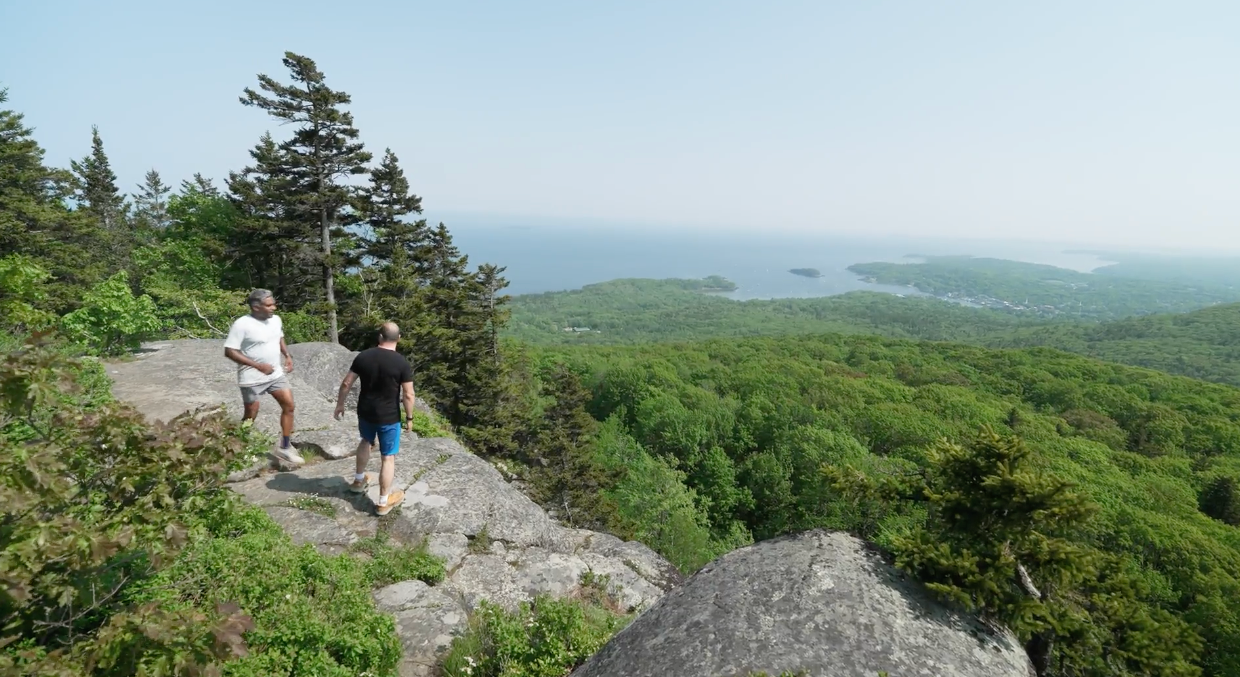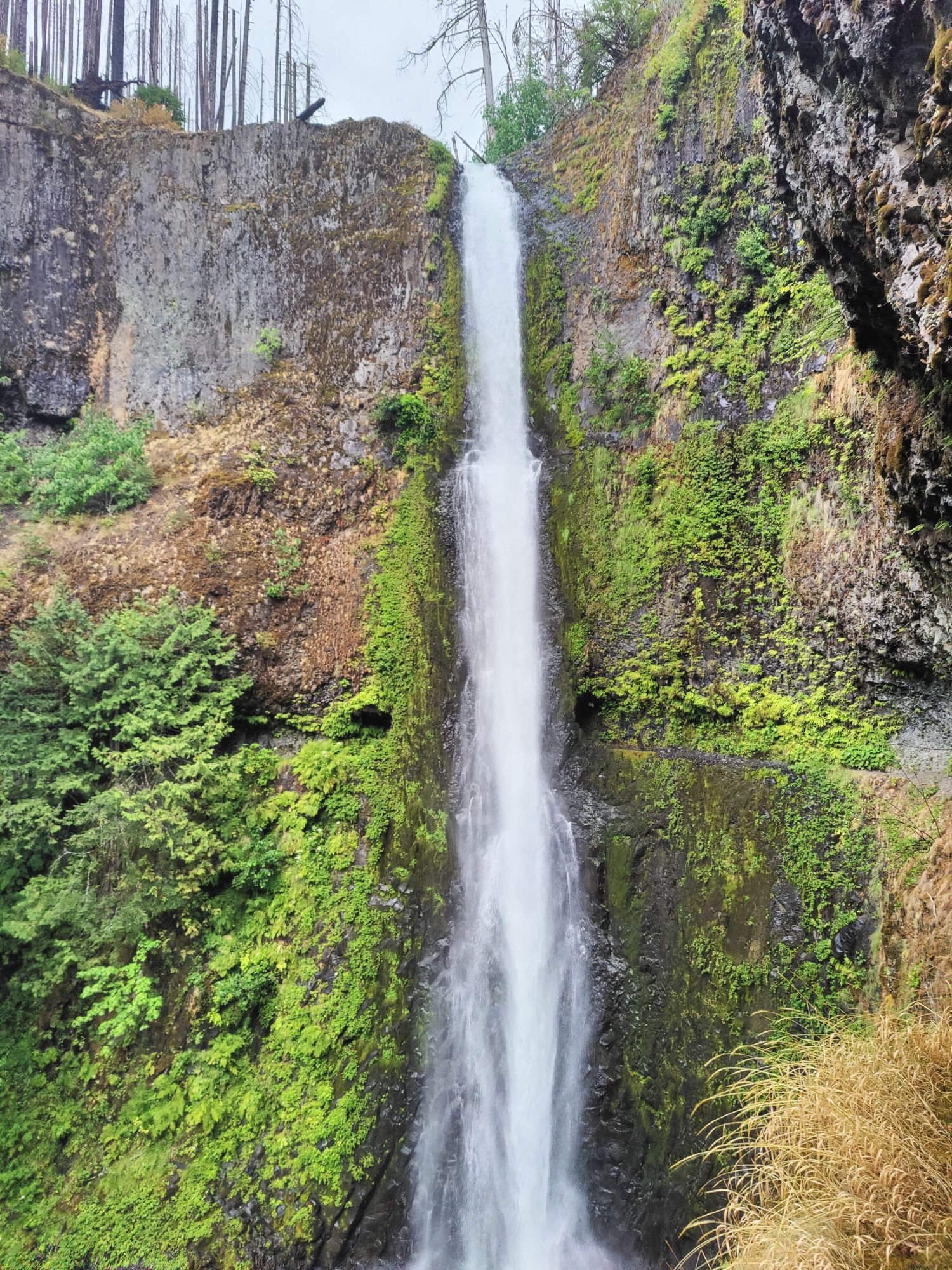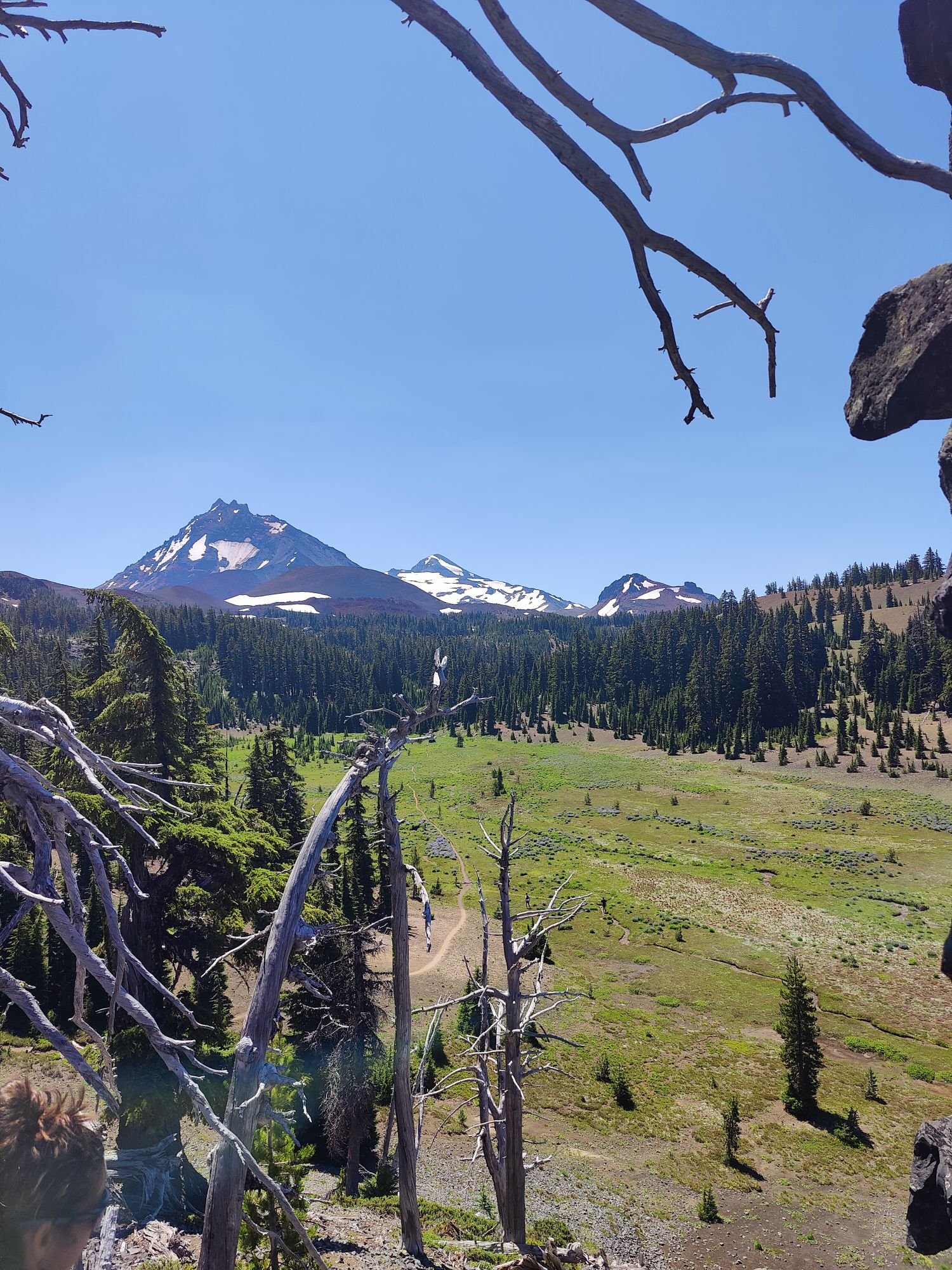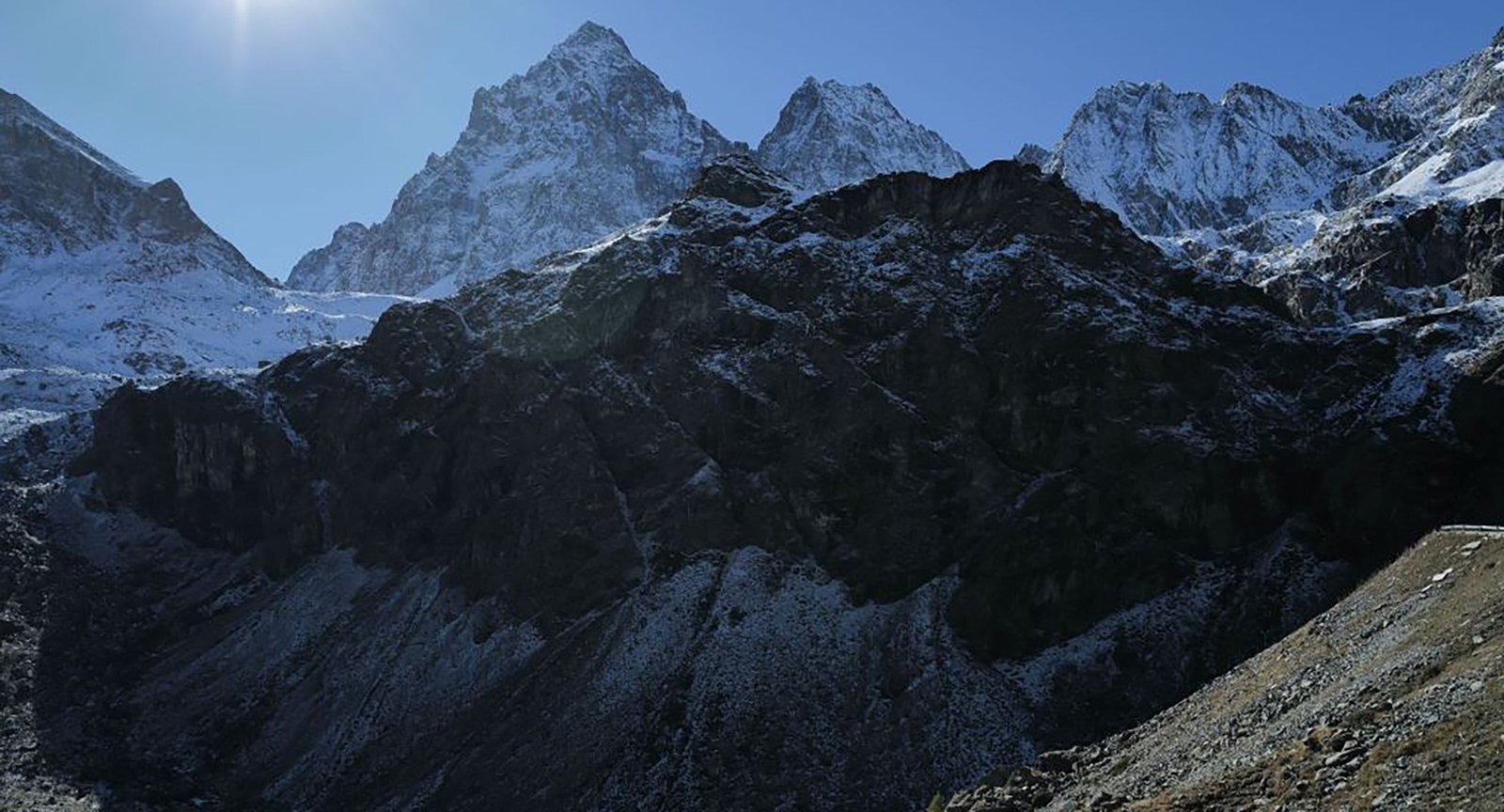Published August 8, 2025 12:28PM
Destinations & Things To Do
‘The Road Less Eaten’ Explores Aquaculture in Three Maine Towns

In the latest episode of The Road Less Eaten, chef and host Biju Thomas visits three coastal towns in Maine, and aquaculture as a whole
Chef Biju in Camden, Maine (Photo: The Road Less Eaten)
In the latest episode of The Road Less Eaten, chef and host Biju Thomas visits three coastal towns in Maine, where life has been shaped by the land, the sea, and as Thomas says, “the people who make a living from both.”
There is a term for this in the East: aquaculture. Along the coast in towns like Freeport, Camden, and Biddeford, aquaculture knits together communities, grows local and larger economies, and cares for the planet.
Thomas explores it— and coastal life in Maine— by learning from a kelp harvester, walking on (yes, on) acres of wild blueberry farms, and by sitting with award-winning chefs and cocktail engineers who all understand that along the coast of Maine, it’s not just about the food; it’s about the feeling.
Freeport
If you’re visiting Maine, you’ve probably got your mind set on lobster and oysters, but Maine’s food story runs much deeper.
Freeport, a shoe-making and ship-building hub that later turned into a food haven, as drawn world-wide attention for harvesting something much less common: kelp.
Ken Sparta, owner of Spartan Sea Farms and the Freeport Oyster Bar, harvests different kinds of kelp (sugar, skinny, winged) alongside oysters. Most know about oysters, but kelp? It’s nutrient rich, and if harvested right, tasty enough to be a main dish, not just a versatile ingredient.
Kelp is planted in Maine in the fall when the water temperature drops below 50 degrees Fahrenheit. When the temperature rises, the kelp is taken out of the water and driven into town. Fifty thousand pounds of kelp were harvested during the 2025 season in Freeport, Maine.
But what Ken geeks out about the most is the fact that harvesting kelp takes nitrogen and oxygen out of the water, therefore lowering ocean citification and making our planet more sustainable.
“I’m making food for my friends and family and making the ocean a better place,” he says.
Back at Freeport Oyster Bar, Thomas takes on kelp tacos and burgers. “If somebody didn’t tell me I wasn’t eating meat, I wouldn’t have known,” he says. Vodka is sustainably harvested from sugar kelp and distilled in small batches to sell at the bar, too.
Camden
Like Freeport, the small coastal town of Camden was once a 19th century ship-building hub, a protected harbor that eventually brought in artists and foodies alongside sailers. Camden quickly became known for its wild trails, blueberry farms and a food scene deeply rooted in tradition.
“Come late summer, the hills turn a deep, brilliant blue,” Thomas says, walking acres of wild blueberry farm alongside the owner of Brodis Blueberries, Jeremey Howard. “Wild blueberries aren’t the big plump ones you find at the grocery store,” Jeremy says. “They’re smaller, bright, with complex flavor.”
Brodis Blueberries has been running for nine generations, but the blueberries have been growing wild in this part of Maine for 10,000 plus years, though not a single patch was planted, Jeremy says.
“When the glaciers receded, they pushed away the fertile soil, and the only things that liked the acidic, ledgy soil, were blueberries.” Ron Howard, Jeremy’s father, explains how the different shades are different wild plants. Each is genetically different. These wild blueberries genetically modify on their own as they grow and thrive. There’s no need to mess with them.
Thomas tours Barren’s Distillery + Restaurant, where the shelves are stocked with blueberry gin, blueberry vodka, blueberry brandy, and more. The blueberries go through the fermentation process, and when they are complete mesh, (which is a wine at that point) they are put into a still that extracts the alcohol vapors.
“It tastes like booze with a kick of sweetness at the end, with the brandy warmth to it,” Thomas says.
Thomas also meets up with Jeremy’s business partner, Andrew Stewart on a trail run. “Apparently here, we hydrate with distilled fruit, then go run up a mountain,” Thomas jokes. The trails are closer to the ocean, and the views are unreal.
Stewarthelped launch Barren’s waterfront restaurant downtown. It’s become known for its seafood classics alongside its full line-up of blueberry spirits.
Biddeford
Along the Saco river, the town of Biddeford draws in the artistic and the young. It’s a hip, developing area that once stood out in the booming textile industry through the 1900s. Those same mills are now full of chefs and artisans like Kate and Jason Hamm, co-owners of Fish and Whistle, and semi finalists in James Beard awards’ emerging chef category.
Fish and Whistle’s main event is its fish and chips, but the happenin’ new place also serves up some seriously unique sandwiches, like the “squidwhich,” a sandwich full of squid, swallowed up by scored and fried milk bread, and smothered in marina and hot cherry peppers— a seafood lover’s dream.
All the seafood at Fish and Whistle is caught fresh from the gulf of Maine, the couple says.
Thomas also visits Magnus on Water, where he chats with Brian chats with Brian “Cat” Catapang, director of beverage working alongside owner of the place, Julia Russell, to create an incredibly experience for those bustling through Biddeford.
Russell sees Magnus on Water as a neighborhood bar and destination restaurant. It is one of only 37 bars (of 10 in the U.S.) recognized by the pinnacle guide to excellence in cocktail craft.
Thomas joins Catapang as he explains how the “couch surfer” was born, the restaurant’s bread and butter, and a love letter to Maine.
“I would go to the beach and check for surf, if I got skunked, I started collecting some of the high tide water to make some sea salt in house,” Catapang says. “The beach has magical properties that no one tells you about.”
Carrying five-gallon buckets during high tide, Catapang brings fresh salt water back into the restaurant to cook down and add to fresh pineapple juice and egg whites for stabilization. The liquor is made with poblano peppers, creating that zippy experience, just like waves that can pull you under.
Magnus on Water’s chef, Rafael Zimmerman, is constantly experimenting with Peruvian comfort food that makes for a fun menu. During his visit, Thomas tries the restaurant’s most popular dishes and is most impressed by the roasted cabbage, because its flavors catch him by surprise.
There is an energy forming in Biddeford, but not just there, in every quaint town with aquaculture at its core. There is a shared respect for tradition and nature, and for creative dishes and drink that truly embody coastal living.
Destinations & Things To Do
Getting back the feel – The Trek

Starting the second stretch
After the first stretch of the trail which was from Shelter Cove to Santiam Pass, it was time for the second stretch. It started nice with some treats from the Sisters Bakery. Soon the trail led through Mt. Jefferson Wilderness and the number of hikers rose. It seemed like I was just ahead of a smaller bubble which has now caught up to me during my rest days.
The landscapes also changed and so did the way of hiking. No more lakes meant no mosquitos but also no possibilities of swimming anymore. This was good and bad at the same time. I missed my swimming brakes but I did not miss the mosquitos.
Burnt areas
Another reason for the lack of mosquitos were probably the huge burnt areas the trail leads through. It was scary to see how much forest got destroyed, especially knowing that many of these fires happened after 2019. This triggered again a feeling of sadness in me. I told myself that I could have walked through nice forest here if I would have not had to quit the trail and some melancholy caught me. It made me ask myself some almost philosophical questions about if the PCT is still the PCT or not. The trail for sure is the same but the experiences are different was the answer that I came up for myself.
After crossing one of the biggest burnt areas I have ever seen, I finally arrived in an oasis that could probably be considered the highlight of Oregon (with Crater Lake in my opinion). Jefferson Park was insanely beautiful and peaceful. And there were lakes to dip in! It was heavenly after walking through shadowless dust. Additionally it gave a feeling of having reached another milestone.
The milestones this year are all smaller and closer together but they provide a feeling of accomplishment. Compared to 2019 it was only the hiked miles by day that provided such a feeling. I’m really happy that I can perceive the trail at this stage so different than 6 years ago. My concerns and worries about not being in thru hiking shape and not being part of this group slowly diminished.
Trail magic and feeling like being home again
As the number of thru hikers rose, so did the conversations with them. One thing that every hiker wants to hear has been passed along like a beacon by southbounders: Trail Magic. Just before Timothy Lake there are two groups of trail angels providing magic for us hikers. The first one, Carbs, made enormous pancakes for us and the second provided hamburgers, grilled cheese sandwiches and much more. There I could also meet some hikers and get to know them better. Doing so, I got the feeling of belonging back and boy, this was so good.
The following days I jojoed around the same hikers and this feeling of continuity reminded me of my first attempt in 2019. The combination of the Trailmagic and the other hikers finally made me realize that it doesn’t matter if I have not started at the Mexican border and I found my peace in being the hiker I am for this season. The daily mileage I was able to do has also increased so you could say that I was finally back home again.
Timberline Lodge and Hiker Hunger
One of the next stops was the famous Timberline Lodge and its breakfast buffet. It was interesting that this year there was apparently a discussion about if the breakfast or the lunch buffet was better but my choice was definitely the breakfast buffet. Being there it was hilarious to see all the backpacks standing around the lodge and realizing the majority of guests were hikers. The buffet was good for sure but my Hiker Hunger not quite there yet. Anyway, it was a really nice experience and for picking up my resupply box in Government Camp I even got a hitch on the back of a pick-up truck. What else could you ask for?
Leaving Timberline after making some more hiker friends, I took an alternate via Paradise Park which was beautiful and full in bloom. Passing Ramona Falls and camping there shortly after was nice too.
The next day I headed into Eagle Creek to see Tunnel Falls. There I have met 2 other hikers who left the trail and went on a road trip now. We agreed on going to Portland together the next day since this was my planned next stop anyway.
All these spontaneous things, TrailMagic and Angels, Hitches with strangers and making friends with other hikers is what makes this trail so special for me. Of course the nature is beautiful as well but in the end it is the people.
Crossing into Washington soon
Soon I will cross the Bridge of the Gods, I am sure this will be an emotional moment for me that I have imagined in the past 6 years already. Just approaching Cascade Locks caused some shivers for me. More about that later
This website contains affiliate links, which means The Trek may receive a percentage of any product or service you purchase using the links in the articles or advertisements. The buyer pays the same price as they would otherwise, and your purchase helps to support The Trek’s ongoing goal to serve you quality backpacking advice and information. Thanks for your support!
To learn more, please visit the About This Site page.
Destinations & Things To Do
Maiden Peak Shelter: Am I an intruder?

Back on trail, the adventure has begun
After staying in Bend with my friends from 2019, getting the last preparations done, it was time to finally hit the trail again. They dropped me off at Shelter Cove and I wondered how I would feel coming back. There was no big excitement on the drive from Bend to the resort and this made me worry. However, as soon as I was there, things changed.
I could immediately spot other hikers, some in their rain gear which means clothes were in the laundry, others just hanging around. It is fascinating how the eye can spot long distance/thru hikers after spending some time on a long distance trail. All of us wear some sort of uniform that distinct us from others.
At first a little shy because I was all fresh and haven’t hiked at all this year I approached the other hikers in the PCT tent of Shelter Cove. We immediately had nice chats about our trail experiences. It felt good to talk and after an ice cream it was time to head out. When saying good bye to the hikers at Shelter Cove the words “See you out there” and “Happy Trails” struck me.
These were the words that we told each other all the time in 2019 and they triggered a feeling that I have missed for so long. They meant being back on trail and being part of a community of hikers that are out there to not only walk to Canada but to have the best time possible each day.
The first night on trail
It felt like Maiden Peak Shelter would be a good first stop on the trail and I was the first one there. Making sure the door was properly closed to prevent mosquitos from flying in, it was time to make some dinner. Dinner was freeze dried refried beans from back home mixed with some ramen. I hoped to find some more of those beans but things have not changed in the 6 years I was off trail. Freeze dried refried beans are still as rare as a gem.
After a while other hikers came in and we talked about how terrible the mosquitos are and how they are trying to run up to Canada as fast as possible. This is because they are afraid to have to skip sections of the trail due to wildfires. We all went to sleep and the next morning all of them got up around 5am to make big miles. They were chatting about me still being asleep and not up yet. Doing so they gave me an uncomfortable feeling.
Why should I get up this early? I have no trail legs to cover big miles yet, therefore there is no need to get up so soon. After they have left, I was sitting in the shelter, realizing that I am not in the spheres as I used to be. It was a weird mix of desperation to have trail legs back and also wonder about why these guys apparently were judging. Anyway, it was time to head out and hike.
First days back on trail
The first days of hiking were a mix of running away from mosquitos and taking long breaks on the shore of lakes. Surprisingly few mosquitos found their way to the shores of the lakes which made them really comfortable places to rest. Since it was not possible to walk so many miles, I perceived the landscape around me in a much different way compared to 2019. For example, every lake I passed, I jumped in to swim. While I have been only swimming in 2 lakes in 2019 it was already 6 in the first days this year. That was amazing!
Hiking itself felt easy and getting used to live in a tent was no problem at all. The conversations with other hikers were mostly me talking about my story and almost apologizing that I did not start at the Mexican border. Even though the hikers did not care about me not having started at the border, I still felt I did not belong to them.
Three Sisters Wilderness
After being chased by countless mosquitos in a green tunnel, only interrupted by burnt areas, suddenly some vistas opened up. The Three Sisters Wilderness was the first of many small milestones that I could reach and it was breathtaking. Since leaving the trail in 2019 I dreamt about this part of the trail and walking over the lava fields. Finally I was there. Joy and excitement mixed and provided energy for some hotter days. It was also necessary for the mosquitos because they have changed. Less in numbers but much more aggressive than in the woods they tested my patience a lot. Many meadows in the area invited for breaks and there were some nice talks with day hikers. Long distance hikers were in much lesser numbers and I wondered where they were.
But more about this in the following post.
This website contains affiliate links, which means The Trek may receive a percentage of any product or service you purchase using the links in the articles or advertisements. The buyer pays the same price as they would otherwise, and your purchase helps to support The Trek’s ongoing goal to serve you quality backpacking advice and information. Thanks for your support!
To learn more, please visit the About This Site page.
Destinations & Things To Do
Artificial Intelligence Helped Rescuers Find a Climber’s Remains

Officials in Italy used a combination of flying drones and AI software to locate the remains of a man who vanished in September
Monviso mountain towers above Turin (Photo: Vittorio Zunino Celotto / Getty Images)
Published August 8, 2025 01:51PM
Back in September 2024, a 64-year-old climber went missing in Italy’s Cottian Alps.
In late July, rescuers finally found his body, using a combination of flying drones and an advanced artificial intelligence software program, according to WIRED Italia.
Nicola Ivaldo, a doctor from Liguria, disappeared on the north face of 12,602-foot Monviso on September 14. Colleagues reported him missing when he failed to show up at work two days later, and search efforts began on September 17.
Ivaldo was an experienced mountaineer, but he was climbing alone. Monviso, which sits near the French border roughly 40 miles southwest of Turin, is a rugged, technical peak.
He also had not told his friends or family his intended route. However, before his disappearance, Ivaldo’s cell phone had connected to a cell tower north of the mountain, so rescuers believed he was attempting to climb Monviso from the north, likely via the peak’s northwest ridge.
Over the next several days, drones, sniffer dogs, and helicopters began poring across the northern and western slopes of Monviso, scouring a search area of 452 acres. But the rugged, dangerous terrain, coupled with bouts of foul weather and poor visibility—wind, rain, fog, and snow—stymied search and rescue efforts. By October, early winter snows had fallen on the mountain, covering any sign of the missing climber’s body. The search for Nicola Ivaldo was called off on October 9.
For nearly a year, the missing doctor’s fate was uncertain. But in late July, two drones, piloted by Italy’s National Alpine and Speleological Rescue Corps (CNSAS) took up the search again.
On the afternoon of July 29, the pair of drones flew over Monviso. During a span of just five hours, they documented almost every inch of the 452-acre search area, taking roughly 2,600 high-definition photographs from 165 feet above the ground. Later that day, these photographs were fed through an artificial intelligence built to recognize variances in color and shape. This software was directed to analyze the photos with specific focus on any irregularities in the landscape.
The AI program analyzed all 2,600 images the same day. What would have taken weeks or months, scanning hundreds of photos with human eyes, took a few hours. The software flagged a series of suspicious spots, including a smattering of bright red pixels that rescuers thought might be Ivaldo’s helmet.
They were right.
Less than three days after the initial drone flights, a recovery helicopter found Ivaldo’s body at approximately 10,335 feet, face down in a couloir high on the north face of Monviso.
One of the two drone pilots, Saverio Isola, told Wired Italia that the miraculous recovery was “a human achievement, but without technology, it would have been an impossible mission.”
Isola explained that Italian rescue crews have been using drones in a similar capacity for roughly five years. “In the recovery operations following the Marmolada glacier tragedy, it allowed us to operate in inaccessible areas and recover all the necessary artifacts,” Isola said. “It prevented the rescuers from risking their lives.” However, artificial intelligence analysis technologies like the kind used in this operation have only been in use for the last eighteen months. These tools were developed by the CNSAS, in coordination with Italy’s civil aviation agency.
Rescue teams across the United States commonly use aerial drones to spot missing hikers, and to scour hundreds of acres of terrain when a helicopter is not readily available. In 2021, a drone equipped with thermal imaging spotted a missing hiker outside of Santa Barbara.
In 2023, a stranded motorist tied his phone to a drone so he could send an SOS message to rescuers.
But using drones in conjunction with artificial intelligence software to scout photographs is not as common.
The CNSAS hopes that in the future, rapid implementation of artificial intelligence analysis could save missing hikers and climbers before it’s too late. In search and rescue missions for living hikers, color and shape recognition software could be combined with thermal imagery analysis. “AI is also able to interpret thermal data, and provide valuable information in just a few hours,” Isola said. While helicopters or ground rescuers are dispatched, the drones could also deliver lifesaving supplies, like food, water, or first aid kits.
-

 Brand Stories3 weeks ago
Brand Stories3 weeks agoBloom Hotels: A Modern Vision of Hospitality Redefining Travel
-

 Brand Stories2 weeks ago
Brand Stories2 weeks agoCheQin.ai sets a new standard for hotel booking with its AI capabilities: empowering travellers to bargain, choose the best, and book with clarity.
-

 Destinations & Things To Do3 weeks ago
Destinations & Things To Do3 weeks agoUntouched Destinations: Stunning Hidden Gems You Must Visit
-

 Destinations & Things To Do2 weeks ago
Destinations & Things To Do2 weeks agoThis Hidden Beach in India Glows at Night-But Only in One Secret Season
-

 AI in Travel3 weeks ago
AI in Travel3 weeks agoAI Travel Revolution: Must-Have Guide to the Best Experience
-

 Brand Stories1 month ago
Brand Stories1 month agoVoice AI Startup ElevenLabs Plans to Add Hubs Around the World
-

 Brand Stories4 weeks ago
Brand Stories4 weeks agoHow Elon Musk’s rogue Grok chatbot became a cautionary AI tale
-

 Brand Stories2 weeks ago
Brand Stories2 weeks agoContactless Hospitality: Why Remote Management Technology Is Key to Seamless Guest Experiences
-

 Asia Travel Pulse1 month ago
Asia Travel Pulse1 month agoLooking For Adventure In Asia? Here Are 7 Epic Destinations You Need To Experience At Least Once – Zee News
-

 AI in Travel1 month ago
AI in Travel1 month ago‘Will AI take my job?’ A trip to a Beijing fortune-telling bar to see what lies ahead | China



You must be logged in to post a comment Login